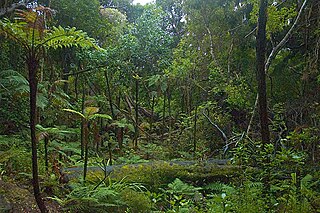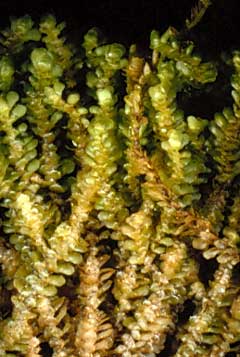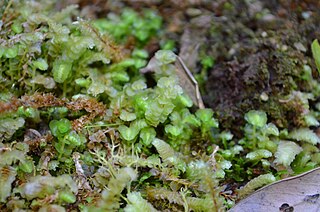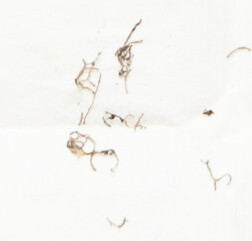
Ulva Island is a small island about 3.5 km (2.17 mi) long lying within Paterson Inlet, which is part of Stewart Island / Rakiura in New Zealand.

Jungermanniales is the largest order of liverworts. They are distinctive among the liverworts for having thin leaf-like flaps on either side of the stem. Most other liverworts are thalloid, with no leaves. Due to their dorsiventral organization and scale-like, overlapping leaves, the Jungermanniales are sometimes called "scale-mosses".

Jungermanniaceae is the namesake family of leafy liverworts. It is a group of small plants that are widely distributed. Several genera formerly included within the family are now classified in the Myliaceae or Solenostomataceae.

Jungermanniopsida is the largest of three classes within the division Marchantiophyta (liverworts).
Schistochila vitreocincta is a species of liverwort in the family Schistochilaceae. Under its synonym Perssoniella vitreocincta it was the only species in the monotypic genus Perssoniella and family Perssoniellaceae. It is endemic to New Caledonia. Its natural habitat is subtropical or tropical dry forests.
Acrobolbus epiphytus is a liverwort species in the genus Acrobolbus. It occurs in New Zealand.

Cephaloziaceae is a family of liverworts.
Petalophyllum, or petalwort, is a genus of liverworts in the order Fossombroniales.

Acrobolbus pseudosaccatus, synonym Tylimanthus pseudosaccatus, is a bryophyte, a species from the liverwort family Acrobolbaceae. The family grows on logs, rocks, and soil. Under certain circumstances, however, they are epiphyte, growing on other plant species.

Petalophyllum preissii, the lettuce liverwort, is a species of liverwort that is the type species of the family Petalophyllaceae. It is found in Australia and New Zealand, and is at risk of extinction in both countries.
John E. Braggins is a New Zealand botanist and bryologist, known for his research into ferns and liverworts. Braggins lectured at the University of Auckland from 1969 until 2000, during which time he supervised and mentored a significant number of New Zealand botanists. During Braggins' career, he has taken part in the identification of 12 species and one suborder, many of which are endemic New Zealand liverworts.

Frullania truncatistyla is a species of liverwort in the order Porellales. The species was first described by Matt von Konrat, Jörn Hentschel, Jochen Heinrichs and John E. Braggins in 2011, and is native to New Zealand.
Frullania hodgsoniae is a species of liverwort in the order Porellales, native to New Zealand. The species was first described by Matt Von Konrat, Jörn Hentschel, Jochen Heinrichs, John E. Braggins and Tamás Pócs in 2010.
Lepidozia bragginsiana is a species of liverwort in the order Jungermanniales, native to New Zealand. The species was first described by Endymion Dante Cooper and Matthew Anton Martyn Renner in 2014.

Libertia cranwelliae is a species of flowering plant in the family Iridaceae. The plant was first described by Dan Blanchon, Brian Grant Murray and John E. Braggins in 2002, and is native to New Zealand.

Libertia mooreae is a species of flowering plant in the family Iridaceae. The plant was first described by Dan Blanchon, Brian Grant Murray and John E. Braggins in 2002, and is native to New Zealand.

Zoopsis nitida is a species of liverwort in the family Lepidoziaceae. The species was first described by David Glenny, John E. Braggins and Rudolf M. Schuster in 1997.

Schizophyllopsis is a genus of liverworts belonging to the family Anastrophyllaceae. The Anastrophyllum subgenus Schizophyllum was elevated to genus status by Jiří Váňa and Lars Söderström in 2013, however due to Schizophyllum being a name for a pre-existing genus, this was rectified and the new genus Schizophyllopsis was created.

Schizophyllopsis papillosa is a species of liverwort in the family Anastrophyllaceae. The species was first identified as Anastrophyllum papillosum by John J. Engel and John E. Braggins and Rudolf M. Schuster in 1998.

Riccardia furtiva is a species of liverwort in the family Aneuraceae. The species was first identified by Elizabeth Brown and John E. Braggins in 1989. R. furtiva is found in Australia and New Zealand, and is an epiphyte, growing on the base of other bryophyte species in shaded peaty areas.












